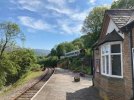Your idea is something I’ve thought about before. The government from the 1980’s would have probably loved to implement your idea. Instead, to save money, they compromised and chose to replace old DMU’s with a bus-like train called a pacer, which, until quite recently were still being used on many parts of the rail network. They were cheap to run, saving money and reducing fares for passengers and some argue saved some branch lines from closing down. They have an interesting history and if you want to find out more about them then there’s plenty of info available on the internet.
But I’ve sometimes thought. Why not take it a step further and convert some railways to busways (or just private tarmac high speed roadways) or maybe light rail/tramways?
It would be a poor solution for busy commuter routes like say London to Brighton where you need long trains to transport high volumes of people, or for high speed routes with large passenger numbers and big gaps between stations, but I think it would be a good cost-effective solution for routes with low speed limits, small passenger numbers and smaller gaps between stations. Routes like my locale (Colne - Preston), Preston - Ormskirk, Settle - Carlisle and Darlington - Bishop Auckland.
Routes where there’s only 1 train per hour (or even less), usually consisting of a 2 car sprinter unit (or even a 1 car 153) and previously a class 142 pacer train (essentially a bus on rails) and only a small handful of passengers. For these lines, converting it to a busway/tramway, or even just building new cheap rail buses would be a great cost effective solution.
You could also increase the frequency to a bus or tram every half hourly (or even quarter hourly) which would not be viable with heavy rail. I think for routes like this, I don’t think it would be any slower either due to the low speed limits, smaller distance between stations and the slow acceleration of diesel sprinter trains. If anything, it might actually be quicker, due to the faster acceleration and better braking of buses. Buses can go faster round curves too, whereas trains can only safely go round tight curves at 10-20 mph.
They converted the Oldham Loop in Manchester from heavy rail into a tramway about 15 years ago and it was a big success (having previously been operated by pacer trains with a lot of squealing and bouncing) so I don’t see why other routes can’t do the same.
Why are such motorised vehicles allowed on public pedestrian pavements when electric scooters and boards with a sentient being aboard (well a teenager anyway) are not?
To be honest, I don’t have a problem with people who ride electric scooters, skateboards or push bikes on the pavement, as long as they’re being careful and not going at 90 miles an hour. It’s one of those things that is technically illegal (like not cleaning up after a dog, which is a much bigger issue) but is never or rarely enforced. E-scooters are a great way to commute to work but many public transport operators are now reluctant to accept them for some reason, even though many of them can be folded up and take up less space than a bike.

